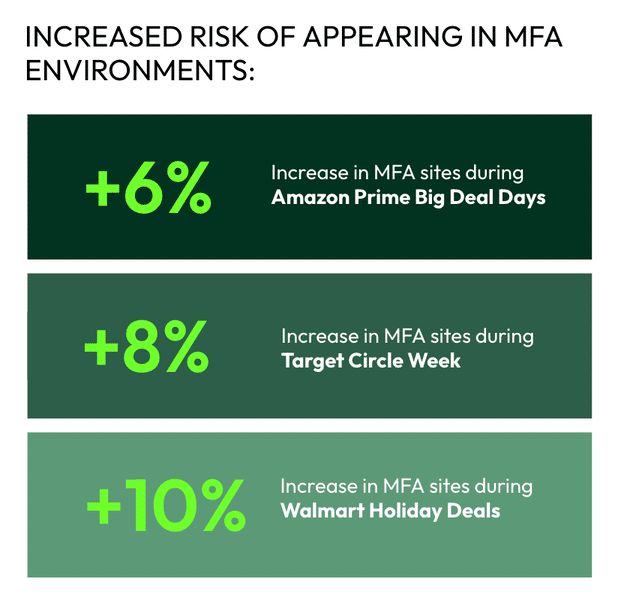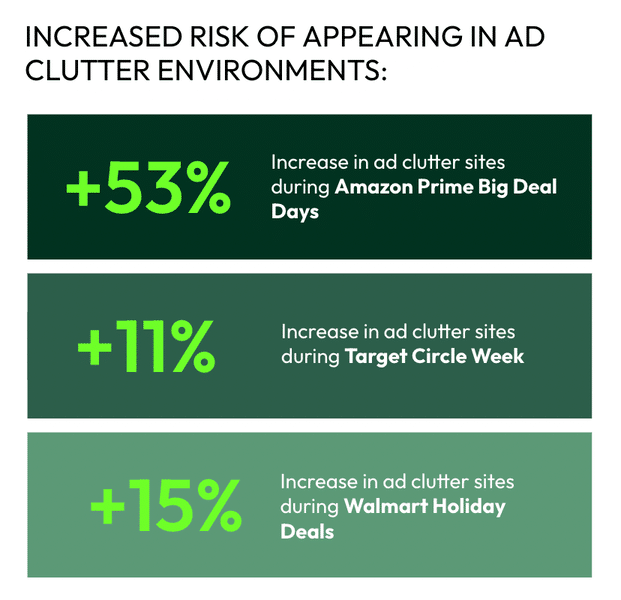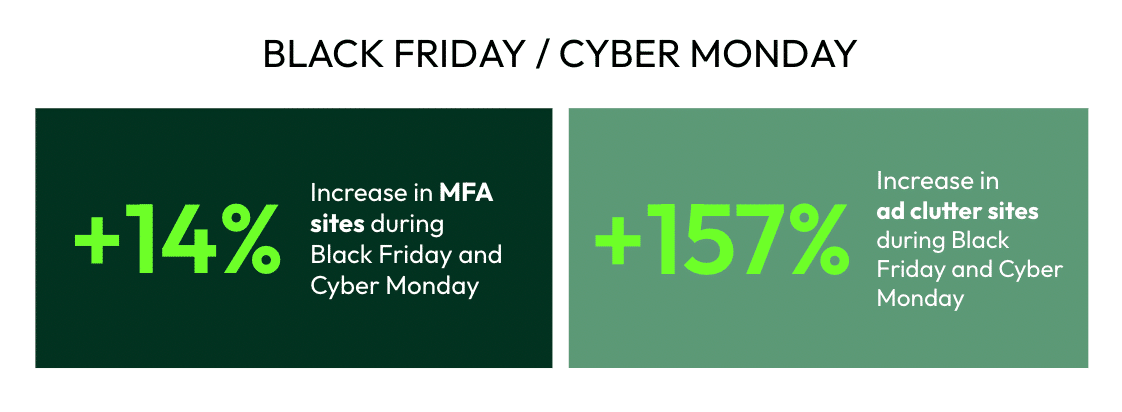Retail deal days arrive with the promise of unprecedented reach and record-breaking sales. Yet beneath the impressive campaign metrics lies a harsh reality: as inventory expands to meet demand, advertising quality can deteriorate.
The intensity of modern deal seasons — Amazon Prime Big Deal Days, Walmart Holiday Deals, Target Circle Week, and the Black Friday/Cyber Monday finale — drives digital advertising competition. Brands pour massive budgets into compressed time windows, creating a perfect storm of inflated costs, cluttered ad environments, and opportunistic low-quality inventory that thrives in the chaos.
For marketers navigating these high-stakes periods, understanding the hidden risks of ad clutter and Made-for-Advertising (MFA) site proliferation isn’t just about protecting budgets — it’s about ensuring every impression drives meaningful consumer engagement when attention is most valuable and scarce.
Defining MFA, Ad Clutter, and AI Slop Sites
Before we understand the impact of MFA sites and ad clutter on programmatic campaigns, we first need to understand what constitutes MFA and ad clutter, and where AI slop fits into the puzzle.
- MFA sites are web pages built to conduct ad arbitrage and feature low quality content (e.g. spam sites or ad farms) created solely to serve ads.
- Ad clutter sites feature high ad density and high ad-to-content ratio, leading to lower performance.
- AI-generated slop sites are considered ad clutter, though they aren’t one and the same. IAS found that 57% of consumers consider spammy sites inappropriate content, and another 70% say they trust brands less when advertising near inappropriate content.
The impact of MFA and ad clutter sites on campaign performance is massive. In an IAS analysis, we found that conversion rates on quality sites are 174% higher than conversion on MFA sites, and 91% higher than conversions on ad clutter sites. Marketers who don’t avoid MFA and ad clutter sites aren’t just showing up in the wrong places — they’re also missing out on sales.
Elevated Risks During Amazon Prime Big Deal Days and Other Deal Days
When retail calendars hit their tentpole events, MFA and ad clutter risks escalate sharply. Amazon Prime Big Deal Days, Target Circle Week, and Walmart Holiday Deals are designed to drive mass consumer attention and spending — but they also trigger a surge in low-quality inventory that marketers must navigate.
According to IAS analysis, MFA rates climb during each of these events, rising by 6% during Amazon Prime Big Deal Days, 8% during Target Circle Week, and an even higher 10% during Walmart Holiday Deals.

At the same time, ad clutter rates escalate even more dramatically, with spikes of 53% on Amazon Prime Day, 11% during Target Circle Week, and 15% during Walmart Holiday Deals.

These numbers paint a stark picture: as consumers flock to these shopping windows, low-quality inventory floods the ecosystem with ad clutter and MFA sites designed to siphon ad dollars.
For advertisers, this means higher costs for placements that make little to no impact. And instead of amplifying brand presence during high-demand periods, budgets can become spread thin across irrelevant, low-quality environments.
Marketers who proactively filter MFA and ad clutter inventory protect their investments and keep performance tied to real consumer engagement — not digital noise.
Black Friday and Cyber Monday: More Shoppers, More Clutter
If retail-specific deal days raise the stakes, Black Friday and Cyber Monday take them to the extreme. These back-to-back events compress unprecedented consumer demand into a single long weekend, creating a key moment for both marketers and bad actors in the digital ecosystem.
The data tells the story: MFA rates jump 14% before versus during Black Friday and Cyber Monday, while ad clutter rates skyrocket by a staggering 157%.

For marketers, the takeaway is clear: retail deal days demand vigilance, but Black Friday and Cyber Monday require airtight safeguards against MFA and ad clutter. Every impression must be intentional, appearing in environments that consumers both trust and engage with.
How IAS Helps During Peak Deal Seasons
When the digital ad environment reaches its most chaotic during Amazon Prime Big Deal Days, Walmart Holiday Deals, Target Circle Week, or Black Friday and Cyber Monday, maintaining control of quality is vital.
This holiday season, avoid all MFA and ad clutter sites as identified by IAS’s AI-driven MFA site classification technology. IAS empowers marketers with predictive science that pre-screens pages so you can filter out content that is not suitable for your brand while not overblocking potentially appropriate or positive contexts, before a bid is even placed.
Access our latest guide, “Break Through the Holiday Noise,” to find out how to best leverage these tools this holiday season. Because in moments when sales matter most, every impression should count.
 Share on LinkedIn
Share on LinkedIn Share on X
Share on X

